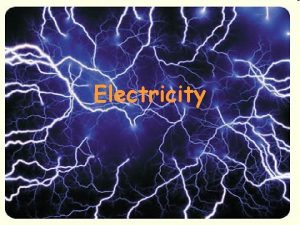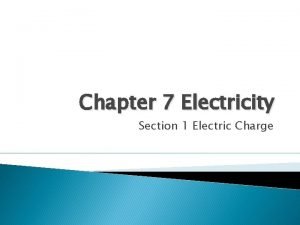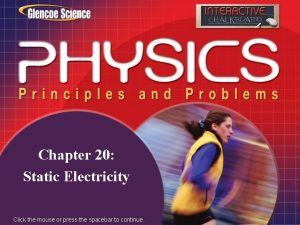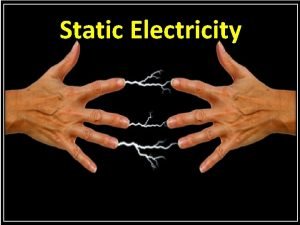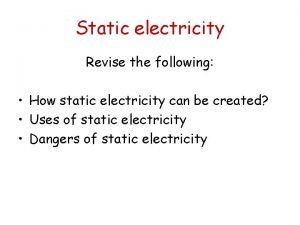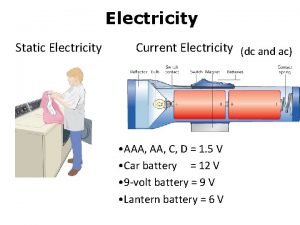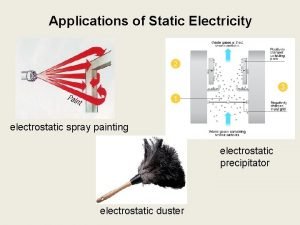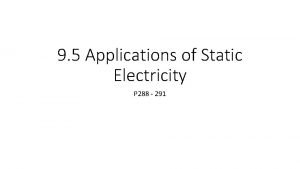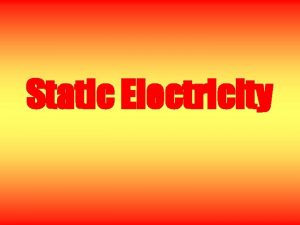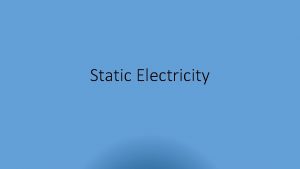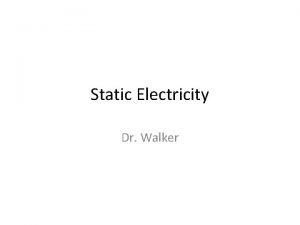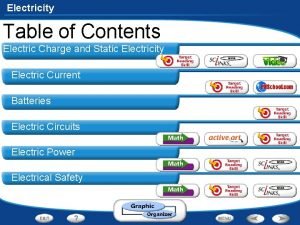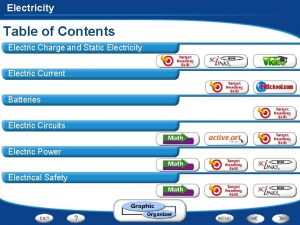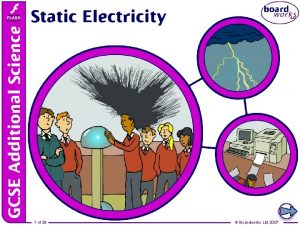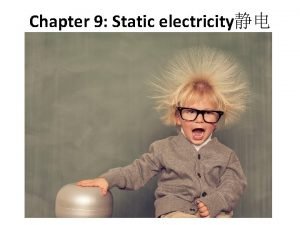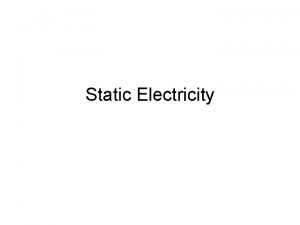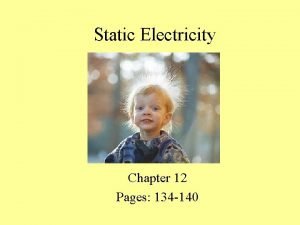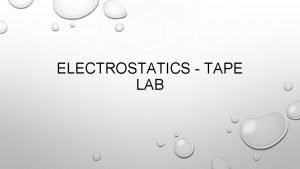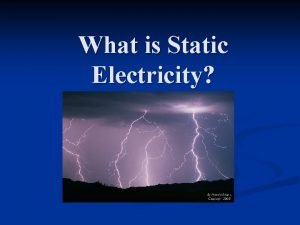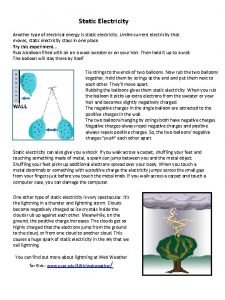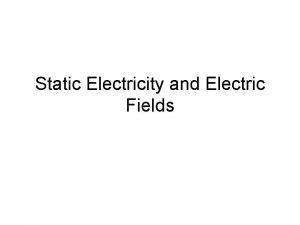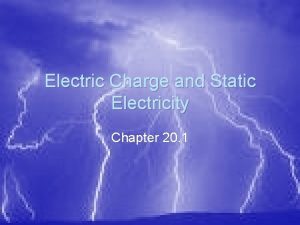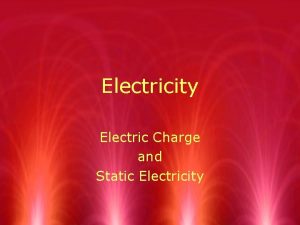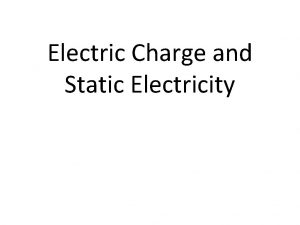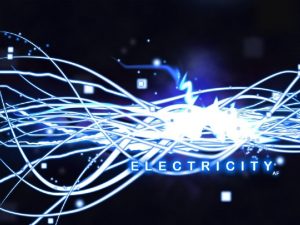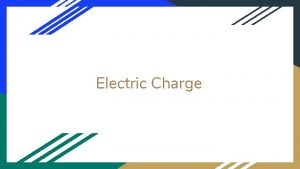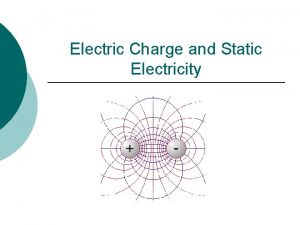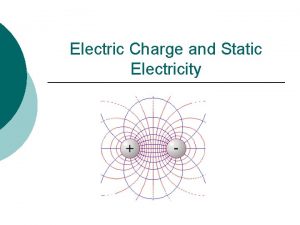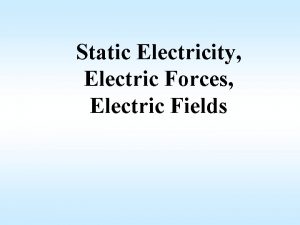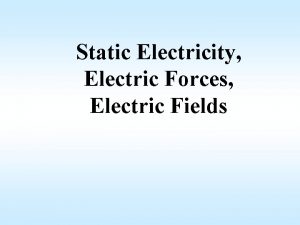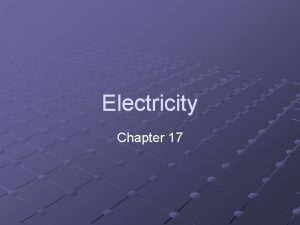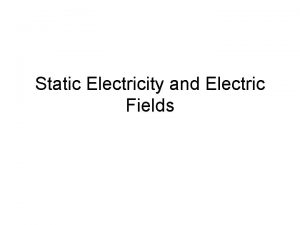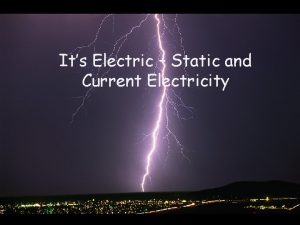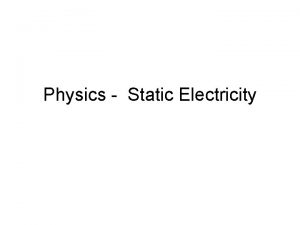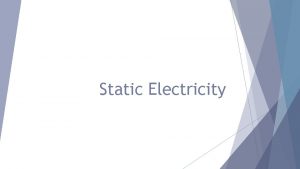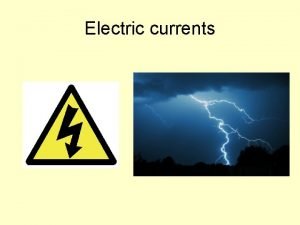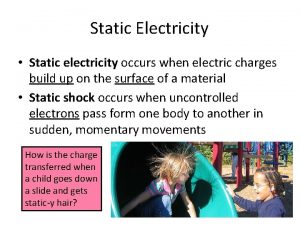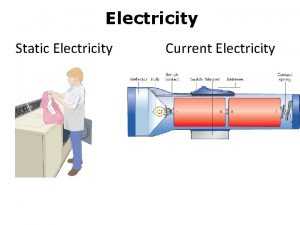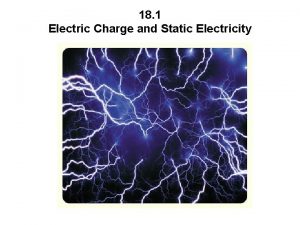Electric Charge and Static Electricity Chapter 20 1






































- Slides: 38

Electric Charge and Static Electricity Chapter 20. 1

Lets Review… Types of Electric Charge The charged parts of atoms are electrons and protons. Protons and electrons have opposite charges. Protons have positive (+) charges. Electrons have negative (-) charges.

Atomic Charges § If an atom has a neutral charge, the number of PROTONS is equal to the number of ELECTRONS. § If the atom has MORE protons than electrons, it has an overall POSITIVE charge. § If the atom has MORE electrons than protons, it has an overall NEGATIVE charge. § If an atom has a negative or positive charge, it is called an ION!!!

Electric Forces and Electric Fields § What keeps electrons “swarming” around the nucleus? – The PROTONS! They like one another! § All objects that have a charge have an ELECTRIC FORCE which either ATTRACTS or REPELS other objects.

Interactions Between Charges that are the same Charges that are different repel each other. attract each other.

Electric Forces § The electric force between two objects (how much they like one another) depends on the DISTANCE between them and the amount of charge on the object. § The closer an object is to another object, the GREATER the electric forces acting on them!!

Electric Fields An electric charge exerts a force through the electric field that surrounds the charge. When a charged particle is placed in the electric field of another charged particle, it is either pushed or pulled.

Static Charge § It is difficult to remove protons from a nucleus BUT electrons can move from ATOM to ATOM and from OBJECT to OBJECT. § IN CLASS EXAMPLE: Balloon and Hair! – The electrons move from your hair to the balloon, your hair becomes more POSITIVELY charged. – Since the balloon gains ELECTRONS it becomes NEGATIVELY charged. – Remember opposite charges ATTRACT!

Static Charge The buildup of charges on an object is called static electricity. When a negatively charged object and a positively charged object are brought together, electrons move until both objects have the same charge. The rapid movement of excess charge from one place to another is an electric discharge.

INSULATORS and CONDUCTORS § Insulators: Materials in which electrons cannot move easily! – Examples: Plastic, wood, glass § Conductors: Materials in which electrons move easily through it. Electrons are not so friendly with their protons and move around. – Examples: Copper, gold, aluminum

Lightning and Grounding • Lightning is another example of an electric discharge. • In a storm cloud, air currents sometimes cause the bottom of the cloud to become negatively charged. • This negative charge induces a positive charge in the ground below the cloud. • A cloud-to-ground lightning stroke occurs when electric charge moves between the negative cloud and the positive ground.

Lightning and Grounding • Since a lightning bolt releases such a large amount of electrical energy, it can be deadly. • The process of providing a pathway to drain excess charge into the Earth is called grounding. • A lightning rod can protect a building from being damaged by a lightning strike by rerouting the electricity to the ground.

Lightning Rods The Empire State Building gets hit by lightning an average of 20 -25 times each year!!

Transferring Charge There are three methods by which charges are transferred: 1) Friction – the transfer of electrons from one object to another by rubbing. 2) Conduction – the transfer of electrons from a charge object to another object by direct contact. 3) Induction – The movement of electrons to one part of an object by another electric field.

Static Discharge When a negatively charged object and a positively charged object are brought together, electrons move until both objects have the same charge. The loss of static electricity as electric charge move off an object is called static discharge.

Weather and Static There is less static discharge on humid days. Why? – On humid days, the air is filled with water molecules, which carries off the extra electrons.

Review Question #1 How do particles with the same charge interact? Particles with the same charge repel each other. How do particles with opposite charges interact? Particles with opposite charges attract each other.

Section 4 Review Question #2 What is static electricity? Static electricity is the buildup of charge.

Section 4 Review Question #3 What are three ways by which static charge is produced? Static charge can build up by friction, conduction, or induction.

Section 4 Review Question #4 How is static electricity discharged? During electric discharge, charges escape the charged object by jumping from one object to another or by attaching to water or dust particles.

Chapter 20 Section 20. 2 (Electric Currents) Section 20. 3 (Electric Circuits)

Flow of a Charge § An electric current is a steady flow of electric charge. § Electric charges will flow continuously only through a closed conducting loop called a circuit.

How a Current Flows § A simple electric circuit contains a source of electrical energy, such as a battery, and an electrical conductor, such as a wire. § In the figure, a closed path is formed by wires connecting a light bulb to a battery.

Voltage § In an electric circuit, a battery increases the electrical potential energy of electrons. § Voltage is a measure of how much electrical potential energy each electron can gain. § Voltage is measured in volts (v).

Batteries § Chemical reactions in batteries produce an electric field in batteries which cause electrons to move from the positive (+) to negative (-) terminal. § Batteries contain only a limited amount of the chemicals needed to create this electric field. § When the battery runs out of the chemicals, it is “dead”.

Resistance § The measure of how difficult it is for electrons to flow through a material is called resistance. § The unit for resistance is the ohm (Ω). § Insulators generally have much higher resistance than conductors.

Ohm’s Law § Ohm’s Law states: § Voltage (V) = Current (Amps) * Resistance (Ω) § According to Ohm’s Law, when the voltage in a circuit increases the current increases. § Example – Just as water flows faster from a bucket that is raised higher.

WHAT IS AN ELECTRICAL CIRCUIT? § Answer: – A closed path that allows an electrical current to flow from a power source (i. e. , batteries). Electricity flows from the negative terminal to the positive terminal. – If there any “breaks” in the loop, electricity will not flow! – There are two types of circuits we will build: 1. Series 2. Parallel

Series Circuits If all the parts of an electric current are connected one after another, the circuit is a series circuit. In a series circuit, there is only one path for the current to take.

Series Circuits - Demonstration Advantage – Very simple to design and build. Disadvantage – A burned-out bulb is a break in the circuit, and there is no other path for the charges to take. Disadvantage – Light bulbs in the circuit become dimmer as more bulbs are added. Why? Bulbs add more resistance. Ohm’s Law – if resistance increases, current decreases.

Parallel Circuits In a parallel circuit, the different parts of the circuit are on separate branches. In a parallel circuit, there are several paths for current to take.

Parallel Circuits - Demonstration Disadvantage – More complicated to design and build. Advantage – If one bulb goes out, the others remain lit. Advantage – If more bulbs/branches are added, the bulbs do not become dimmer. Why? More paths to take = less resistance = more current

Build a Series Circuit Using the two batteries and three bulbs at your station, build a Series Circuit with the people at your lab station. Take turns building the circuit.

Build a Parallel Circuit Using the two batteries and three bulbs at your station, build a Parallel Circuit with the people at your lab station. Take turns building the circuit.

Review Question # 1 § Compare and contrast an electric discharge with an electric current.

Review Question # 2 § Describe how a battery causes electrons to move in a circuit.

Review Question # 3 § Compare the current in two light bulbs wired in a series circuit.

Review Question # 4 § Explain why a building is wired using parallel circuits rather than series circuits.
 Static electricity and current electricity
Static electricity and current electricity Electricity n
Electricity n Electricity and magnetism vocabulary
Electricity and magnetism vocabulary Chapter 6 electricity section 1 electric charge answers
Chapter 6 electricity section 1 electric charge answers Chapter 21 electric charge and electric field
Chapter 21 electric charge and electric field Chapter 21 electric charge and electric field
Chapter 21 electric charge and electric field Coulombs constant units
Coulombs constant units Chapter 21 electric charge and electric field
Chapter 21 electric charge and electric field Section 1 electric charge crossword puzzle answers
Section 1 electric charge crossword puzzle answers Electricity section 1 electric charge
Electricity section 1 electric charge Difference between charge and electric charge
Difference between charge and electric charge Difference between static and current electricity
Difference between static and current electricity Static electricity chapter 20 answers
Static electricity chapter 20 answers Chapter 17 section 1 electric charge and force answer key
Chapter 17 section 1 electric charge and force answer key Static electricity
Static electricity How does static electricity work
How does static electricity work Bill nye current electricity
Bill nye current electricity Who invented electricity
Who invented electricity Electric current
Electric current How is static electricity used in spray painting
How is static electricity used in spray painting Static electricity painting
Static electricity painting Stationary electric charge
Stationary electric charge Static electricity examples
Static electricity examples What is triboelectric series
What is triboelectric series Graphic organizer electric current
Graphic organizer electric current Electric current graphic organizer
Electric current graphic organizer Static electricity summary
Static electricity summary Static electricity
Static electricity Static electricity
Static electricity Static electricity
Static electricity Static electricity
Static electricity Static electricity tape lab
Static electricity tape lab Is cotton negatively charged
Is cotton negatively charged Static electricity one cloud to another
Static electricity one cloud to another Static electricity review
Static electricity review Types of charges
Types of charges Electric charge is
Electric charge is Static electricity by calamityofcolors
Static electricity by calamityofcolors Venn diagram of series circuit and parallel circuit
Venn diagram of series circuit and parallel circuit








